
A map detail showing North Staffordshire. Published by Henry Teesdale & Co., London, 1832. (Courtesy, Chipstone Foundation.)

Dishes, Burslem, ca. 1690. Slipware. (Left) D. 13 1/4 ". (Courtesy, Potteries Museum & Art Gallery; photo, David Barker.) These badly warped slipware dishes, recovered from a waste pit in Burslem, are one of the most common types of vessel produced at this time. Almost ninety dishes were found on this site. Very similar dishes have been found at Port Royal, Jamaica, where they were lost during the devastating earthquake of 1692.

Various vessels, Staffordshire, ca. 1690. Slipware. Two-handled cup. H. 4 1/2". (Courtesy, Potteries Museum & Art Gallery; photo, David Barker.) These slipware vessels excavated from Burslem Market Place (the so-called Sadler’s Site) provide a cross section of typical decorated wares of the late seventeenth century. Drinking vessels predominate, and slip decoration, while commonplace, is generally simple.

Plate, Staffordshire, ca. 1830. Whiteware. D. 4 1/2". (Courtesy, Donald Carpentier; photo, Gavin Ashworth.) The sentiment expressed on this plate from the 1830s, “commerce, The Staffordshire Potteries/And free trade with all the world,” would have been shared by all the Staffordshire manufacturers of the period. This transfer-printed pattern highlights the importance of trade to the survival of the Staffordshire pottery industry.
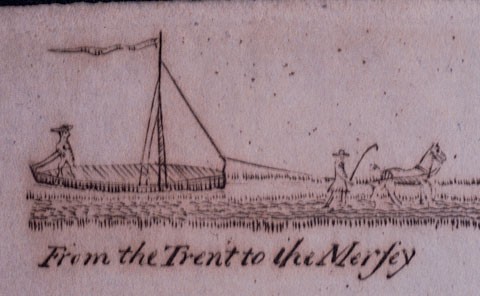
“From the Trent to the Mersey.” Unpublished letterhead, Navigation Office, Stoke, 1800. (John Wood Archives, Potteries Museum & Art Gallery.) The canal, completed in 1777, gave the Staffordshire potteries direct access to the sea. This facilitated an already flourishing trade and significantly reduced the cost of moving raw materials and finished goods.

Archaeological excavation showing large fragments of Staffordshire creamware in a large circa 1780 refuse deposit at a Virginia plantation site. (Photo, Robert Hunter.)
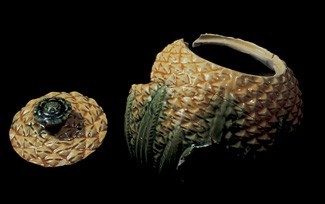
Teapot fragment and lid, Staffordshire, ca. 1770. Creamware. (Photo, Robert Hunter.) An example of a typical Staffordshire product exported to North America.

Tea canister, attributed to William Greatbatch, Staffordshire, 1765–1770. Creamware. H. 4 1/4". (Courtesy, Troy Chappell; photo, Gavin Ashworth.)

Biscuit and glazed sherds, Livesley, Powell & Co. and J. W. Pankhurst & Co, Hanley, 1850–1862. Whiteware. (Courtesy, Potteries Museum & Art Gallery; photo, David Barker.) These wares, often called white granite or ironstone china, were excavated in Hanley from a waste dump used by these two local firms.

Plate and archaeological fragments, Podmore, Walker & Co., Tunstall, ca. 1845. Whiteware. D. 7 5/8". (Courtesy, Potteries Museum & Art Gallery; photo, David Barker.) This company had extensive trade with North America. Sherds of the pattern “Manilla,” printed in flow blue and recovered from one of the firm’s waste dumps, are shown alongside a finished plate with the same design.

Plate, Podmore, Walker & Co., Tunstall, ca. 1845. Whiteware. D. 9 7/8". (Private collection; photo, David Barker.) This plate is printed in the “Washington Vase” pattern in flow mulberry.

Printed sherds, Podmore, Walker & Co., Tunstall, ca. 1845. Whiteware. Examples of the “Washington Vase” pattern, found in one of the firm’s Tunstall waste dumps. (Courtesy, Potteries Museum & Art Gallery; photo, David Barker.)

Cup and saucer, Podmore, Walker & Co., Tunstall, ca. 1855. Whiteware. Saucer D. 4 7/8". (Private collection; photo, Gavin Ashworth.) Fragments of the “Eagle” pattern have been recovered from domestic sites in the mid-Atlantic region of the United States.

Biscuit and glazed industrial or factory-made slipware waste, Copeland factory, ca. 1850. Whiteware with slip decoration. (Courtesy, Potteries Museum & Art Gallery; photo, David Barker.) These sherds were recovered from a dump adjacent to the Spode factory in Stoke-on-Trent. The sherds are all from “London shape” bowls and are unusual in that they bear the impressed mark “copeland.”
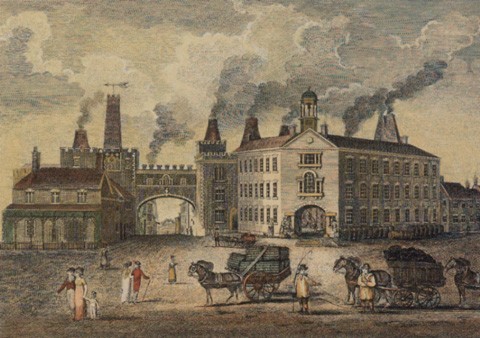
“West view of the manufactory of Messrs. Enoch Wood & Sons—Burslem.” Unknown artist and engraver, 1830–1840. (Courtesy, Chipstone Foundation.) The origin and history of this important print and the print illustrated in fig. 16 are unknown. They may be early proof copies dating to circa 1833. The handwritten titles conflict with later engraved versions, which have the direction information reversed. This view of the entrance of the Fountain Place Works shows a procession of tradesmen’s carts before the elegant façade of the pottery works.

“East view of the manufactory of Messrs. Enoch Wood & Sons—Burslem.” Unknown artist and engraver, 1830–1840. (Courtesy, Chipstone Foundation.) A published version of this view is included in Ward’s History of Stoke-on-Trent (1843). This view shows the extensive arrangement of the pottery works, Enoch Wood’s house, and extensive gardens.

Industrial or factory-made slipwares, Enoch Wood & Sons, Burslem, ca. 1835. Whiteware. (Courtesy, Potteries Museum & Art Gallery; photo, David Barker.) These fragments were recovered from a large town-center waste dump at Burslem Market Place. Although these types of low-priced wares were made by many manufacturers, it is unusual to be able to attribute them to a specific maker. Their discovery here with a mass of marked wares confirms their manufacture by Enoch Wood & Sons, and the archaeological context in which they were found dates them to circa 1835.

Various painted vessels, Enoch Wood & Sons, Burslem, ca. 1835. Pearlware and whiteware. (Courtesy, Potteries Museum & Art Gallery; photo, David Barker.) Some examples of a wide range of painted earthenwares by Enoch Wood & Sons. These were excavated from the Burslem Market Place waste dump, where they were deposited in circa 1835.
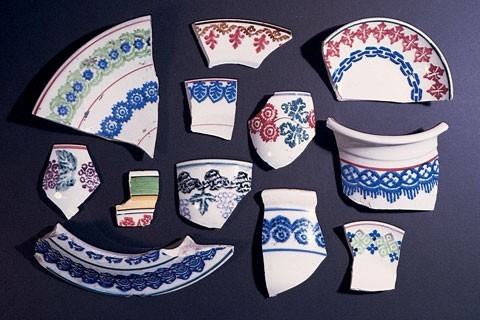
Sponge-decorated sherds, probably from William Baker & Co., Fenton, ca. 1860. Whiteware. (Courtesy, Potteries Museum & Art Gallery; photo, David Barker.) Increasing quantities of archaeologically recovered sponged wares now highlight the importance of these cheap wares from the Staffordshire pottery industry and its export trade.
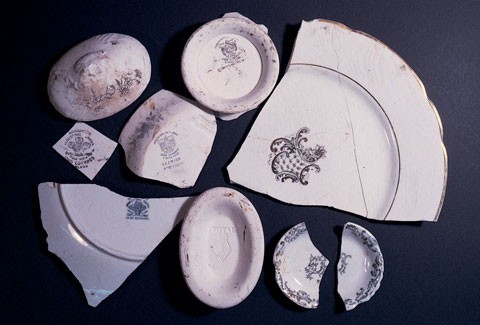
Sherds, James Edwards, Fenton, 1875–1890. Whiteware. (Courtesy, Potteries Museum & Art Gallery; photo, David Barker.) A selection of late-nineteenth-century wares made for export and excavated in the vicinity of James Edwards’s King Street Works. The “Royal” pattern, the subject of a lawsuit over copyright infringement, appears in the sauceboat base shown in the bottom center image; an unclear impressed diamond registration mark is probably for 1877.
